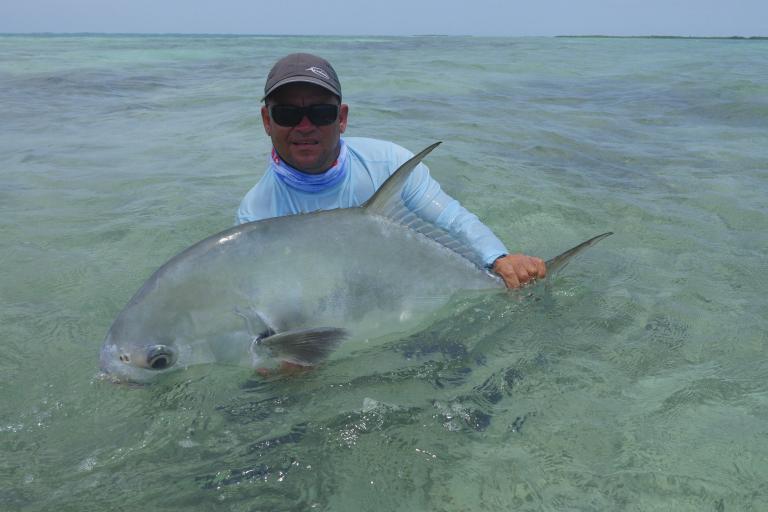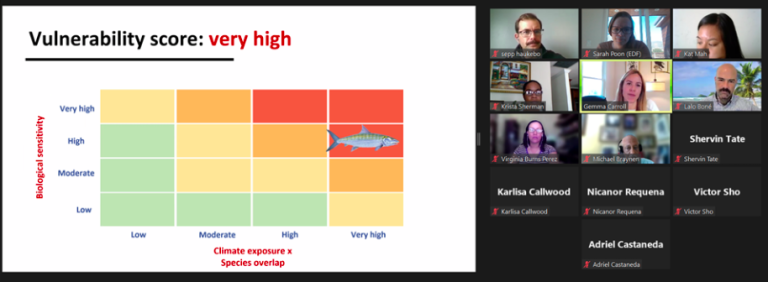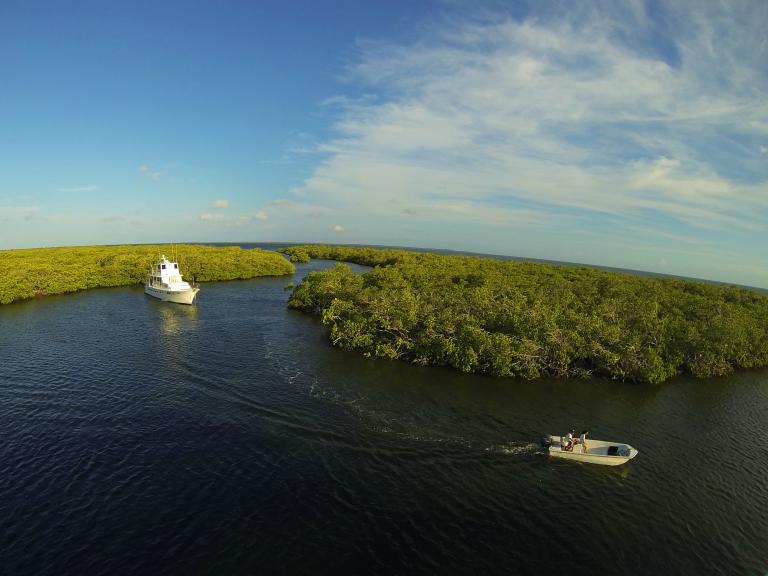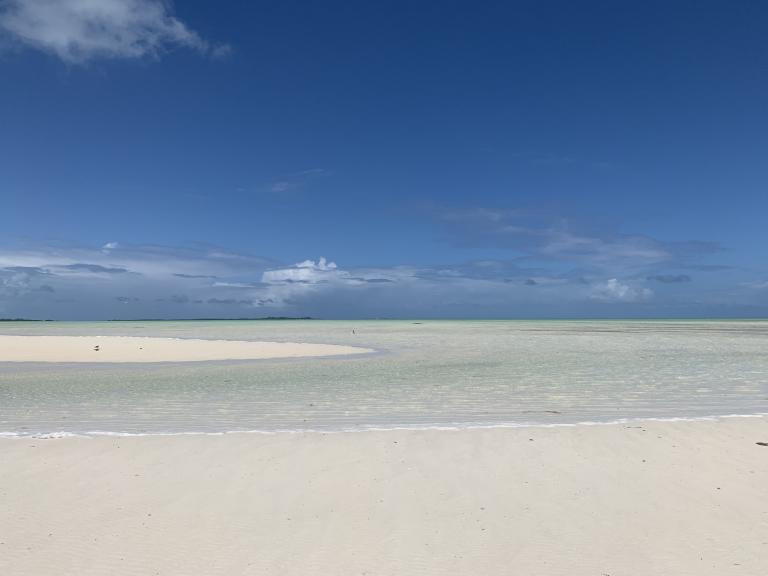

Climate Vulnerability Assessment in Caribbean Recreational Fisheries
Learn how stakeholders in the Caribbean assessed climate threats to their recreational fisheries
Victor Sho, a sport fishing coordinator in Belize, worked with a group of stakeholders throughout the Caribbean to assess how climate change might affect key species of the recreational flats fisheries. They utilized the Climate Vulnerability Assessment (CVA) Tool to estimate the overall vulnerability of these species to climate change. The process brought together fishers, scientists, and managers to prioritize the needs of the fishery and actions to be taken to increase resilience.

The CVA Tool helps prioritize the climate change related risks of the fishery and gives a platform for stakeholders from different backgrounds to build relationships and share knowledge.
Victor Sho: “I’ve been working as the Sport Fishing Coordinator at Coastal Zone Management Authority & Institute in Belize for the past seven years. I work with CZMAI, institutional partners, and stakeholders within local communities to help guide the development of the industry. EDF approached me about doing a climate vulnerability assessment for the recreational fish species in Belize and it was a great opportunity to work along with a variety of different stakeholders and hammer out how we should be prioritizing our work to increase resiliency in the fishery.”
CVA in Action
Expand AllVictor: “Because of the barrier reef and atolls, Belize is home to some of the best flats fishing in the Caribbean, like Cuba and The Bahamas. Recreational fishers come from all over to fly fish the flats of Belize, mainly targeting bonefish, tarpon, and permit. Flat fishing is a big economic earner for the country, especially for coastal communities whose families rely on the year-round recreational flats fishery for their livelihood. A lot of the local fish guides have voluntarily transitioned to becoming recreational fishing guides, as being a guide is more lucrative and reduces the impact on the fishing stock.”
Located within the Caribbean Large Marine Ecosystem, the recreational flats fisheries of Belize and The Bahamas play a key role in the economy and social capital of these two countries. Within each of these fisheries, target species such as bonefish (Albula vulpes), tarpon (Megalops atlanticus), and permit (Trachinotus falcatus) are almost entirely catch and release for recreational use. The Bahamas is one of the most developed recreational flats fisheries in the Caribbean, bringing in nearly $169 million USD annually. Belize’s flats fishery is also well developed, bringing in approximately $60 million USD a year. Many of the guides who work in these fisheries are strong champions for conservation, as they understand the importance of sustainable fishing for their livelihoods.

Victor: “EDF started the CVA process with an initial desktop research. We, the stakeholder group, had the opportunity to submit research articles and the scientist compiled it all into an easy to digest list of species and the climate risk factor for each species. Then the discussion component began. The stakeholders were given the opportunity to remove or add on species based on our personal knowledge of the fishery in Belize. And also adjust some of the climate risks based on our on-the-water knowledge. For example, the fishers see tarpon as a very adaptable species in terms of habitat, so we lowered the risk level on that species. I receive a lot of anecdotal information from local stakeholders; however, transforming anecdotal information in useful quantifiable data is challenging; the CVA Tool gave us an opportunity to do just that. The CVA tool allowed researchers who have information and local fishers who have 20 years of witnessing changes on the water, to sit down together and share knowledge. The CVA Tool helped visualize the risks being faced by different species in a simple, easy to digest way. And once we completed the CVA process in Belize, we were able to have a regional discussion with other recreational fishery stakeholders from the Bahamas and Cuba.”
The CVA Tool provides a framework to assess the relative vulnerability of a suite of fisheries species to climate change, in order to support climate-ready planning and adaptive management. The method looks at the exposure of key species to climate change and other climate related stressors, as well as the sensitivity of the species to those stressors to assess the overall climate vulnerability. By combining desktop research with “on the water” expertise and local scientific knowledge, the CVA Tool can develop a comprehensive and complementary picture of climate change and its likely impacts on fishery species.

Victor: “The CVA Tool helped give the local stakeholders a voice and ensure their local knowledge was really being included as part of the decision-making process. Once the climate exposure and risk of the different species was decided on by the group, we were able to have discussions around what sort of measures can be done locally, nationally, and regionally to combat these expected changes and improve resiliency. We discussed the needs to improve enforcement of existing regulations, more stakeholder participation in decision-making, and maybe a need to expand certain protected areas to take into account more habitat of these species. The CVA process helped us assess the climate risk to important species which teed up discussions on what to prioritize in terms of possible solutions and what are the most cost-effective options that would yield the best results.”
In the Caribbean specifically, the CVA determined that sea level rise and an increase in the severity of storm surges pose the biggest risk to the Caribbean, and all three target species are at high or very high sensitivity to climate exposure. The stakeholder group clearly identified that significant changes are occurring and are expected to continue across a suite of climate variables. Based on the CVA results the group was able to identify socio-economic implications of vulnerability in the fishery and outlined a series of interventions that could be undertaken by governments and communities in Belize and The Bahamas to increase resilience in the recreational sector.

Victor: “While working on the CVA we found there is a need to fill data gaps as it relates to the location of the researched fish species throughout their lifetime. As a result, we have planned a mapping project to be one of the priorities for the coming year. We will map their natural habitats and learn where their corridors lie so that we can properly protect these fish during the entirety of their life cycles.
The process of using the CVA Tool gave us the opportunity to network with others both within Belize and throughout the Caribbean. Building off that, EDF has now helped us organize a recreational fisheries exchange with The Bahamas and Cuba so that we can share information regionally as we start to think about how we want to protect the recreational flats fisheries on a regional scale.”

I would definitely recommend the CVA Tool, to know what challenges climate change is expected to present in your fishery in the near future, and to start to prioritize how to deal with those challenges within the fishing sector.
Advice from User
Victor: “While using the CVA Tool, when you are planning meetings, make sure there is adequate representation from the local communities and strongly advocate for the inclusion of local leaders from the specific area you are researching. For example, in recreational fishing, I’d recommend including the chairperson of the local recreational fishing association. This gives more significance to the report and allows you to capture the views of many community members without having huge meetings. If possible, always make sure to have local researchers at these engagements as well. They are very passionate about what they do and can bring nuggets of wisdom to these discussions.”

